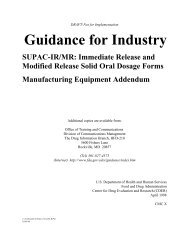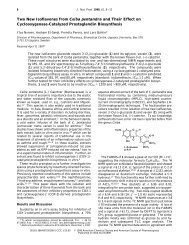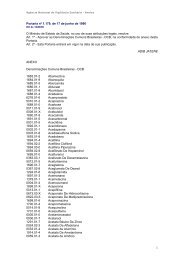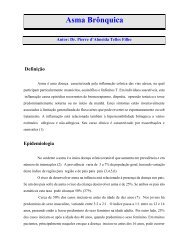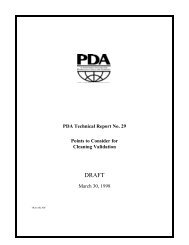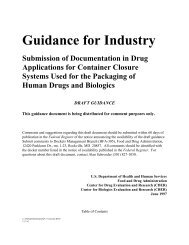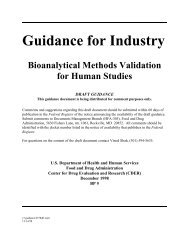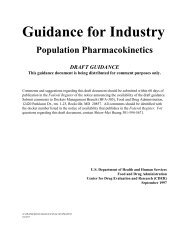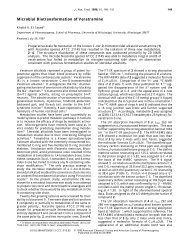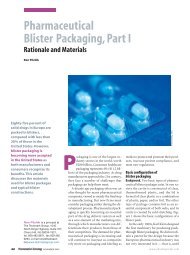ANDAs impurities in drug substances - Pharmanet
ANDAs impurities in drug substances - Pharmanet
ANDAs impurities in drug substances - Pharmanet
- No tags were found...
Create successful ePaper yourself
Turn your PDF publications into a flip-book with our unique Google optimized e-Paper software.
Draft-Not for Implementation112113114115116117118119120C. Residual SolventsThe control of residues of solvents used <strong>in</strong> the manufactur<strong>in</strong>g process for the <strong>drug</strong>substance should be discussed. Any solvents that may appear <strong>in</strong> the <strong>drug</strong> substance shouldbe quantified us<strong>in</strong>g analytical procedures with an appropriate level of sensitivity.Pharmacopoeial or other appropriate procedures should be used. Acceptance criteriashould be based on pharmacopeial standards or known safety data tak<strong>in</strong>g <strong>in</strong>toconsideration dose, duration of treatment, and route of adm<strong>in</strong>istration. Particularattention should be given to quantitation of toxic solvents used <strong>in</strong> the manufactur<strong>in</strong>gprocess as described <strong>in</strong> the ICH guidance Q3C Impurities: Residual Solvents.121IV.ANALYTICAL PROCEDURES122123124125126127128129130131132133134135136The DMF or abbreviated application should <strong>in</strong>clude documented evidence that the analyticalprocedures are validated and suitable for the detection and quantitation of <strong>impurities</strong>. Differences<strong>in</strong> the analytical procedures used dur<strong>in</strong>g development and proposed for the commercial productshould be discussed <strong>in</strong> the DMF or abbreviated application.Organic impurity levels can be measured by a variety of techniques, <strong>in</strong>clud<strong>in</strong>g those that comparean analytical response for an impurity to that of an appropriate reference standard or to theresponse of the <strong>drug</strong> substance itself. Reference standards used <strong>in</strong> the analytical procedures forcontrol of <strong>impurities</strong> should be evaluated and characterized accord<strong>in</strong>g to their <strong>in</strong>tended uses. It isconsidered acceptable to use the <strong>drug</strong> substance to estimate the levels of <strong>impurities</strong> when theresponse factors of the <strong>drug</strong> substance and <strong>impurities</strong> are close. In cases where the responsefactors are not close, this practice may still be acceptable, provided a correction factor is appliedor the <strong>impurities</strong> are, <strong>in</strong> fact, be<strong>in</strong>g overestimated. Analytical procedures used to estimateidentified or unidentified <strong>impurities</strong> are often based on analytical assumptions (e.g., equivalentdetector response). These assumptions should be discussed <strong>in</strong> the DMF submission or abbreviatedapplication.137138139140141142143V. REPORTING IMPURITY CONTENT OF BATCHESAnalytical results should be provided for all batches of the <strong>drug</strong> substance used for stabilitytest<strong>in</strong>g, as well as for batches representative of the proposed commercial process. The content of<strong>in</strong>dividual <strong>impurities</strong>, both identified and unidentified, and total <strong>impurities</strong> observed <strong>in</strong> thesebatches of the <strong>drug</strong> substance should be reported with the analytical procedures <strong>in</strong>dicated. Atabulation (e.g., spreadsheet) of the data is recommended. Impurities should be designated bycode number or by an appropriate descriptor, for example, name or retention time. Levels ofJ:\!GUIDANC\2452DFT.WPDJuly 21, 19985



